Create Task
ImageCenter’s wizard driven interface enables you to create the tasks using the following operating procedures.
-
Click the button in the top bar
The image files in the image list are displayed in the wizard.

-
Right-click on the folder selected in the image list
The image files in the selected image folder are listed in the wizard.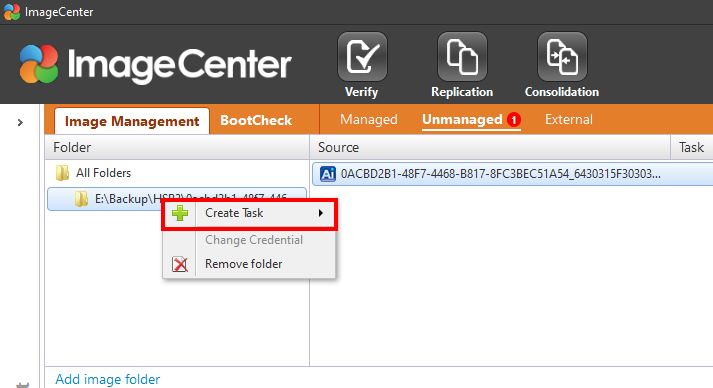
-
Right-click on the image file selected from the image list
Only the selected image file is displayed in the wizard.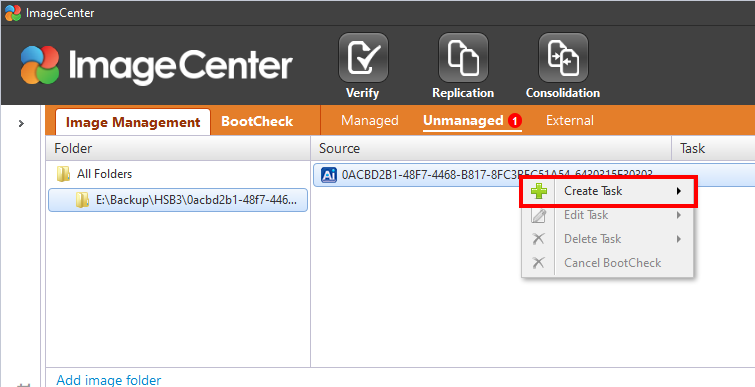
Create Verify Task
Source
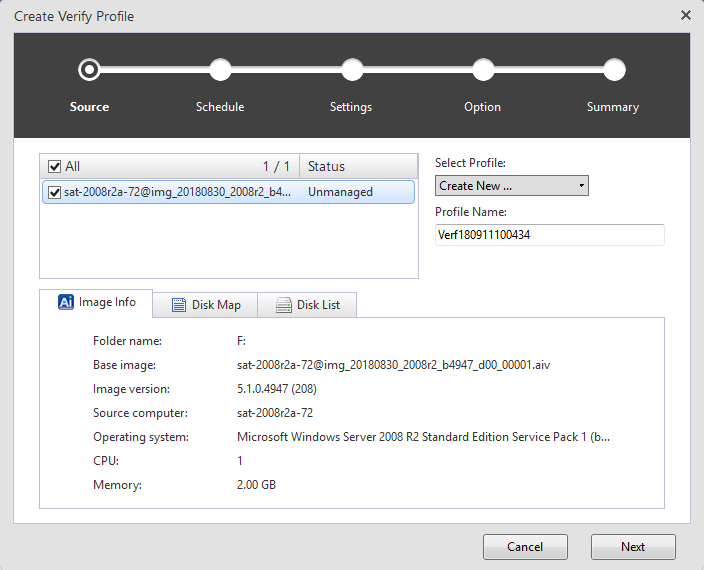
Select the image files to use.
Select [Create New] in [Select Profile] and specify the profile name.
When importing an exported profile, select [Create from Template].
Multiple check boxes can be selected in the image file list. The same task settings can be configured for multiple image files.
The following are the status of the image file.
-
Managed
Image file which you configured a task setting. -
Unmanaged
Image file which neither you nor any other user configured a task setting. -
External Image file which a user other than you configured a task setting.
-
Managed + External
Image file which you or any other user configured a task setting.
Schedule
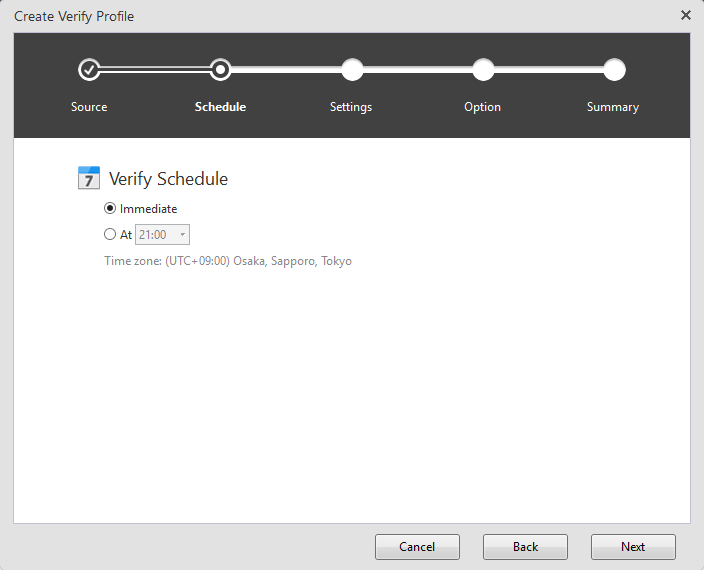
-
Immediate
The task is immediately executed upon creation of a new image. -
At xx:xx
The created task is weekly / monthly executed at the specified time.
Settings
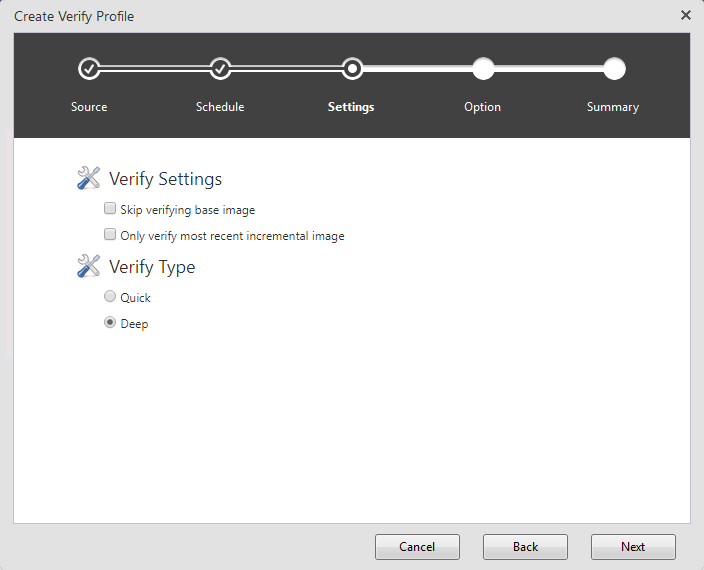
-
Skip verify for base image
Skipping the base image, only incremental image files are verified -
Verify latest new image file only
Only the last created image file in an image set is verified. If this option is not selected, all the image files in the image set are verified.
Verify Type
-
Quick
Checks if internal tampering of the image file has occurred.Backup files created with Version 2022 are supported.
This process is equivalent to Deep Verify for the backup images saved in the destination bucket added with Actiphy StorageServer by using 7.0.1 or earlier version.
The option does not support the backup image files created with ActiveImage Protector 2018 or earlier version.
Option
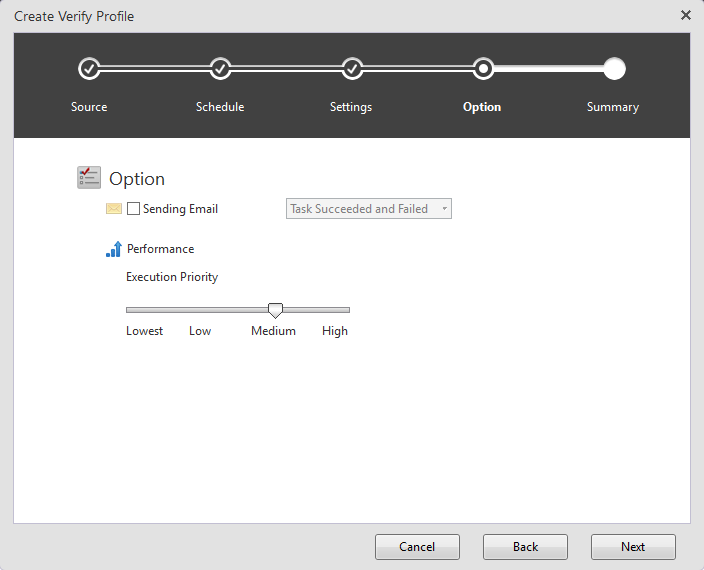
-
Notification
Check in the box for [Send notification] to send E-Mail informing you of a completed task with a specified status. -
Performance
Set the task execution priority.
Summary
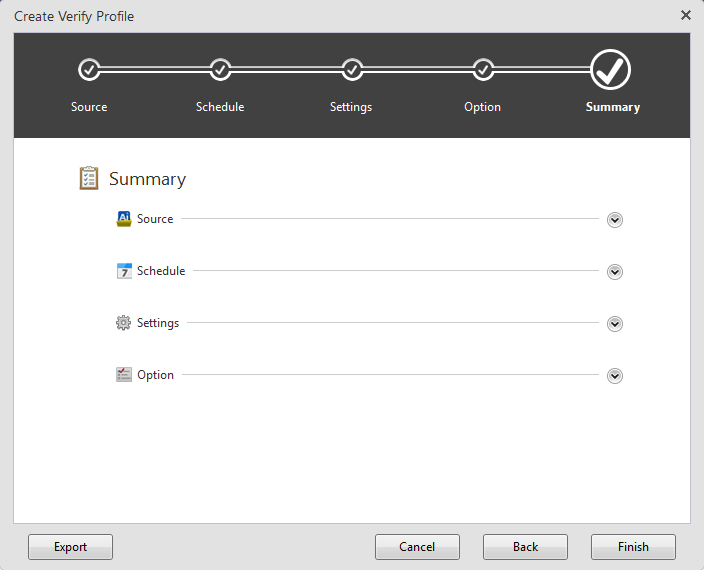
Click [Finish] to complete and save the task configuration. Click [Export] to export and save the configured settings in a template (*.verify).
Create Replication Task
Source
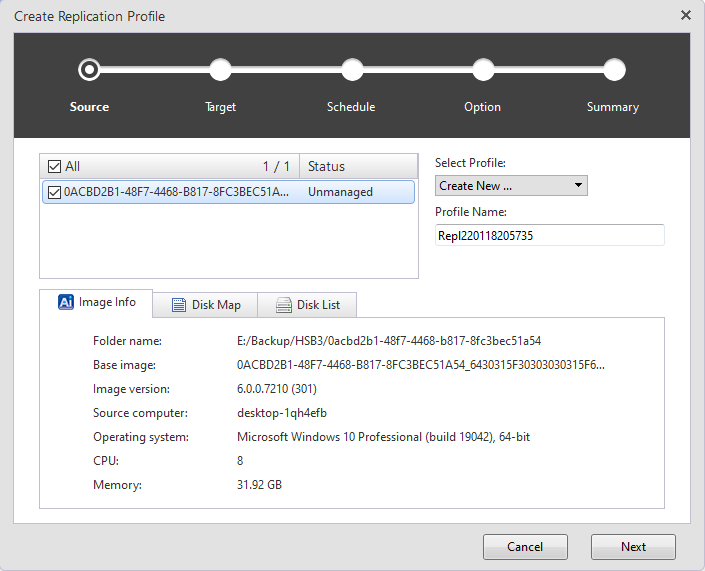
Right-click on the image file in the image list.
Select [Create New] in [Select Profile] and specify the profile name.
When importing an exported profile, select [Create from a template…].
Multiple image files in the list can be selected by clicking the check boxes. A single task may be created for multiple image files.
The following are the status of the image file.
-
Managed Image file which you configured a task setting.
-
Unmanaged Image file which neither you nor any other user configured a task setting.
-
External Image file which a user other than you configured a task setting.
-
Managed + External Image file which you or any other user configured a task setting.
Target
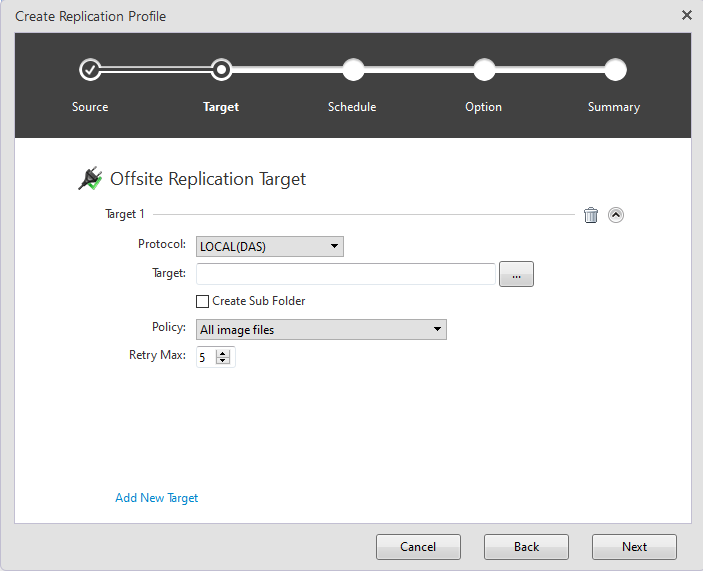
Select a protocol for the offsite replication target from the following. Click the link for the respective targets, enter the credential information and configure the port settings.
Local Folder
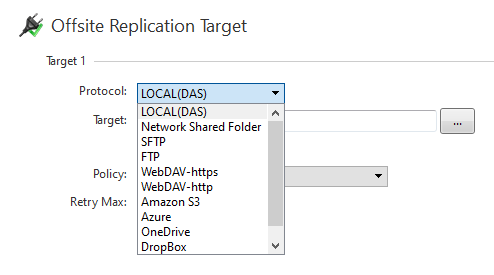
Click […] to browse a folder or specify the path to the location of the folder.
Click [Apply] or [Finish].
Network Shared Folder
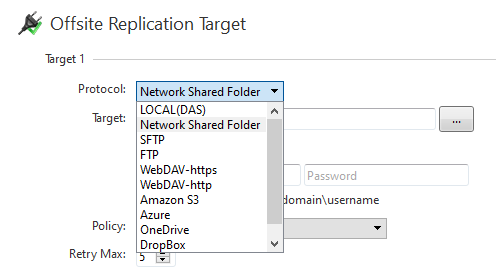
Click […] and specify the folder or enter the path to the replication target and credential information. Click [Apply] or [Finish].
SFTP
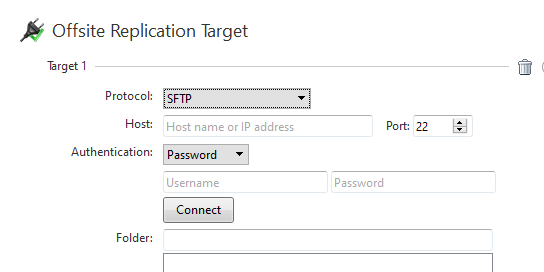
Enter the host name or IP address assigned to the SFTP server as well as the Port number. Enter the credentials information and click [Connect].
Select [Password] or [Private Key] for authentication.
When the connection to the server is successfully established, select a folder in tree view for replication target.
Right-click on a specific folder to create a new folder.
Click [Apply] or [Finish].
FTP
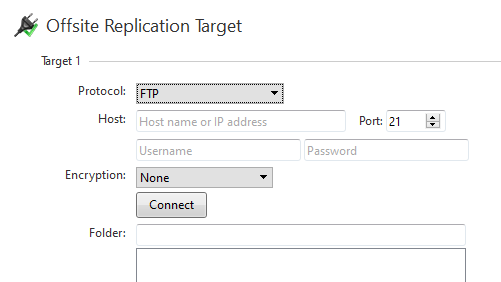
Enter the host name or IP address assigned to the FTP server as well as the Port number. Enter the credentials information and click [Connect].
Select an encryption method and FTPS.
When the connection to the server is successfully established, select a folder in tree view for replication target.
Right-click on a specific folder to create a new folder.
Click [Apply] or [Finish].
WebDAV (https or http)
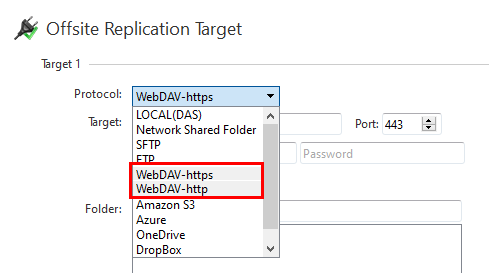
Enter the host name or IP address assigned to the WebDAV server as well as the Port Number. Enter the credentials information and click [Connect].
When the connection to the server is successfully established, select a folder in tree view for replication target.
Right-click on a specific folder to create a new folder.
Click [Apply] or [Finish].
Amazon S3
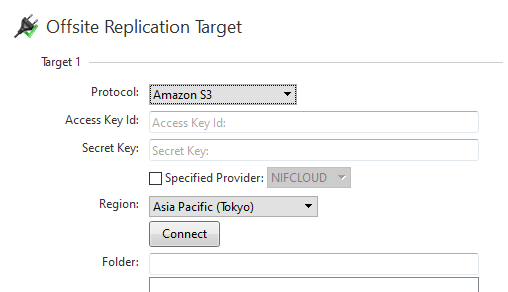
Enter the credentials information and click [Connect].
When the connection to the service is successfully established, select a bucket/folder in the tree view for the replication target. Right-click on a specific folder to create a new folder.
A new bucket cannot be created.
Click [Apply] or [Finish].
Enable [Enter Provider] option to specify the provider.
By default, [NIFCLOUD(east-1)] can be selected.
If selecting a provider other than the default option, click [Add New Target] and configure the following settings:
- Name
Specify any display name you like.
*End Point Enter the End Point provided by the provider.
*Region Enter the region provided by the provider. If not provided by the provider, this item may be left blank.
For more details about how to obtain or verify the respective information, please contact the provider.
Azure
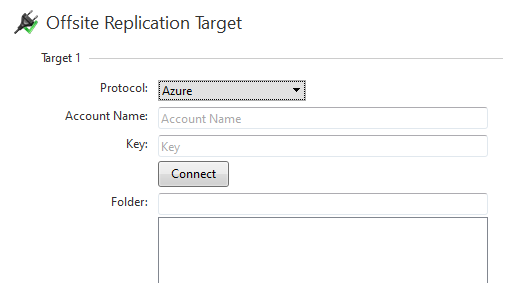
Enter the credential information and click [Connect] button.
When the connection to the service is successfully established, select a container/folder in tree view for replication target.
Right-click on a specific folder to create a new folder.
Click [Apply] or [Finish].
For more details about how to obtain or verify the respective information, please contact the provider.
OneDrive
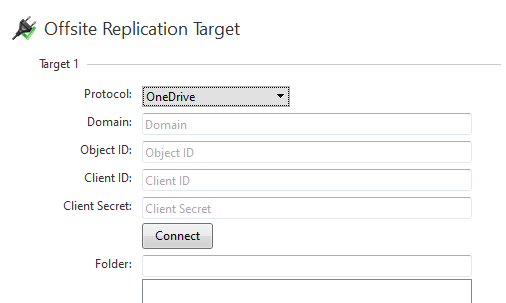
OneDrive for Office 365 Business may be selected for the replication target.
Replication feature supports the maximum file size 15360MB for processing. Replication task for a backup image file exceeding the maximum size will be cancelled. Go to [Advanced] - [General] and enable [Split image into xx MB files] before starting the task.
Enter the credentials information and click [Connect].
-
Domain
Enter the domain name confirmed with Microsoft Azure portal. (Ex: replication.onmicrosoft.com) -
Object ID Enter Object ID for OneDrive Account User confirmed with Azure portal.
-
Client Secret Enter the client secret confirmed with Microsoft Azure portal.
When the connection to the service is successfully established, select a folder in tree view for replication target. Right-click on a specific folder to create a new folder. Click [Apply] or [Finish].
Dropbox
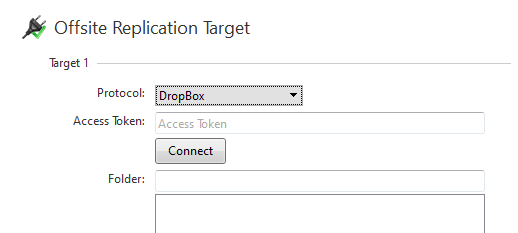
Replication supports the maximum file size 20480MB for processing. The Replication task for a backup image file exceeding the maximum size will be cancelled. It is recommended to select [Advanced Setting] - [General] and enable [Split image into xx MB files] before starting the task.
Enter App key and App Secret generated by Dropbox Developer through application registration. Click [Obtain Access Code] to launch Web browser. Obtain Access Code following the instructions from Dropbox API, enter the obtained Access Code and click [Connect].
When the connection to the service is successfully established, select a folder in tree view for replication target.
Right-click on a specific folder to create a new folder.
Click [Apply] or [Finish].
You are allowed to specify a folder located under “Dropbox > Apps >
For more details about how to obtain the access token, please contact the provider.
Google Drive
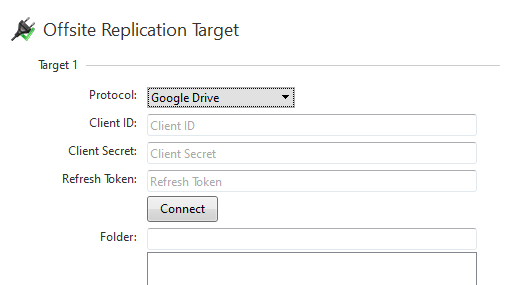
The Replication feature supports the maximum file size 10240MB for processing. Replication tasks for a backup image file exceeding the maximum size will be cancelled. It is recommended to select [Advanced Setting] - [General] and enable [Split image into xx MB files] before starting the task.
Enter the credentials information and click [Connect].
-
Client ID
Enter the Client ID for OAuth client ID issued by Google Cloud Platform. -
Client Secret
Enter the Client Secret for OAuth client ID issued by Google Cloud Platform. -
Refresh Token Enter the Refresh Token issued by Google Developers.
When the connection to the service is successfully established, select a folder in tree view for replication target.
Right-click on a specific folder to create a new folder.
Click [Apply] or [Finish].
For more details about how to obtain or verify the respective information, please contact the provider.
Google Drive API must be enabled on Google Cloud Platform in advance.
Wasabi
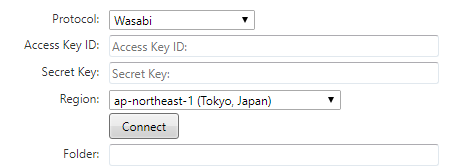
Enter credential information and click [Connect].
When the connection to the service is successfully established, please select a container / folder in the tree view for replication target and click [Select Folder] button.
A new bucket cannot be created.
For further details about how to obtain / monitor the respective information, please contact the service provider.
Click [Add New Target] to add a new replication target.
Click recycle bin to delete the unnecessary replication target.
To stop the replication process, uncheck the box for the replication target instead of deleting.
Configure the following settings for the respective profiles.
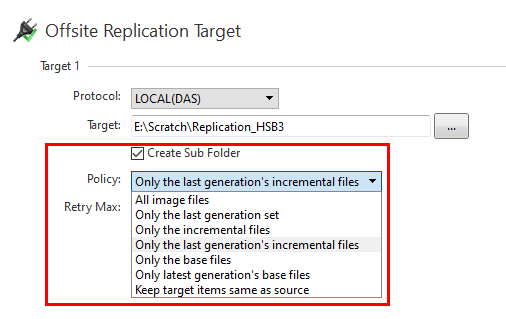
-
Create sub-folder
A sub-folder is created in the specified location to save the replicated backup images (the sub-folder is created in the task name). -
Replication Policy
Select an option for replication policy from the following:-
Replicate all target image files
Check the box to enable replication of the entire target image files. -
Replicate only the last generation
Check the box to enable replication of backup files (including incremental files) of only the latest generation.The most obsolete image set is deleted from the replication target when a new image set is replicated.
-
Replicate only incremental files Check the box to enable replication of only incremental files.
-
Replicate only incremental files of the last generation Check the box to enable replication of only incremental files of the last generation.
The most obsolete image set is deleted from the replication target when a new image set is replicated.
-
Replicate only base files
Check the box to enable replication of the base image files. -
Replicate only base files in the last generation Replicate only base image files in the last generation.
Check the box to enable replication of only base files of the last generation.
-
Keep target items same with source
Check the box so that the target files mirror the files from the source.If the [Keep target items same with source] option is not enabled, the incremental backup image created as a result of the Reconcile settings and numbered back or the consolidated incremental image will not be replicated. The image files deleted from the destination storage according to the predefined retention policy will not be deleted from the replication target.
- Synchronization occurs according to the specified schedule.
-
-
Maximum number of retries
The maximum number of attempts to retry the replication task if the initial task fails.
Schedule
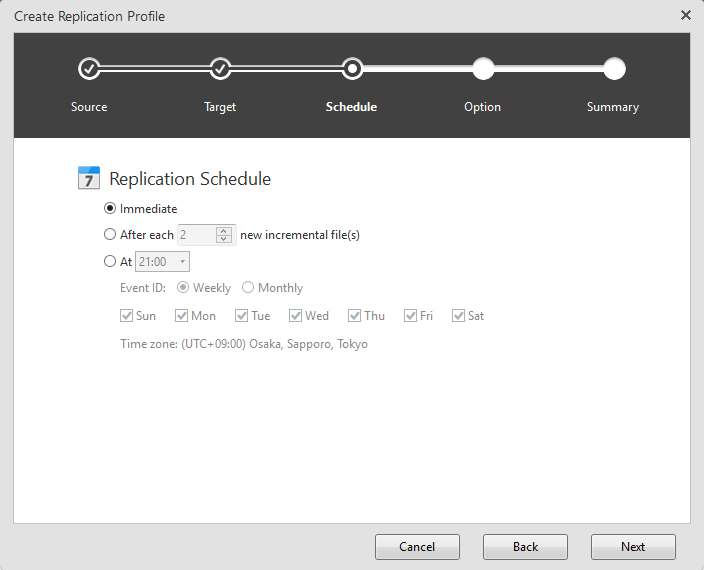
-
Immediate Replication task runs immediately when a new incremental image file is created.
-
After each xx new incremental files Replication task is set to run after a specified number of incremental files have been created.
Even when [Replicate only incremental files of the last generation] option is enabled, the incremental files of every image set are subject to count in.
-
At xx:xx
Replication task is executed weekly or monthly at a specified time.
Option
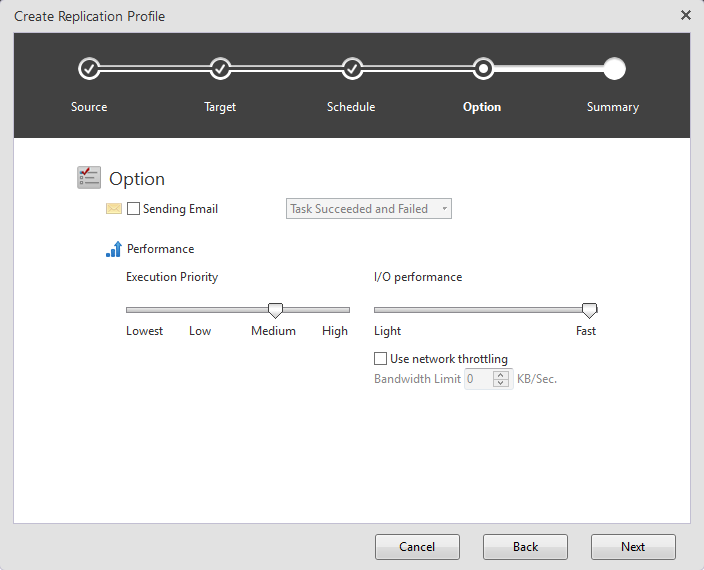
-
Sending E-Mail Check this box to send E-Mail informing you of a task completed with a specified status.
-
Execution Priority
Set Replication task execution priority. -
I/O Performance Set the I/O performance for replication to a local disk or network shared folder.
-
Use network throttling Set the amount of network bandwidth in KB/sec to define the maximum throughput for replication to local disk, network shared folder, SFTP and FTP, Amazon S3 only.
Summary
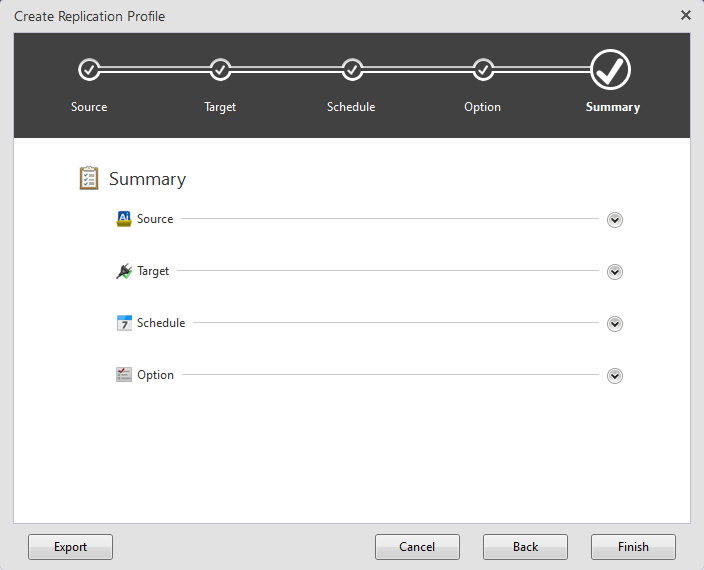
Click [Done] to display the confirmation message for starting the first scheduled backup task.
Click [Export] to save the configured settings in the template (*..replication).
Create Consolidation Task
Source
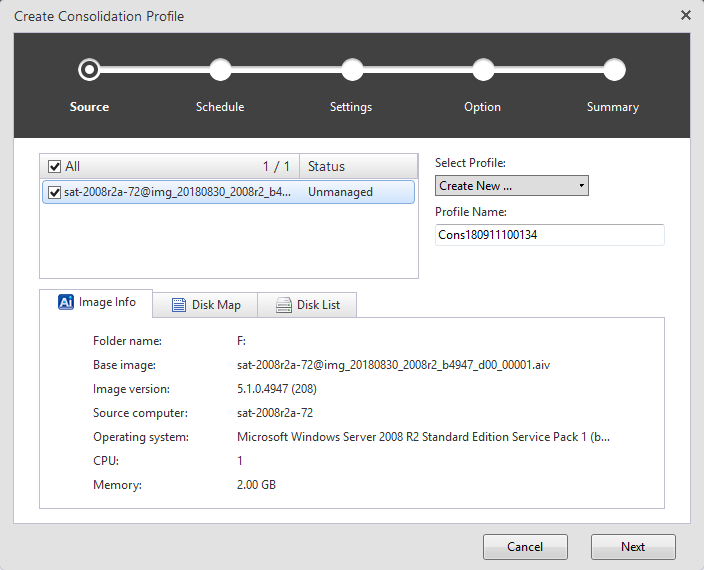
Select the backup images to consolidate.
Select [Select Consolidation Profile] - [Create New] and specify the profile name. To import the exported profile, select [Create from template…].
You can select multiple checkboxes in the image file list. A consolidation task can be created from multiple image file.
In [Status] column, the following is displayed.
-
Managed
Image file which you configured a task setting. -
Unmanaged
Image file which neither you nor any other user configured a task setting. -
External
Image file which a user other than you configured a task setting. -
Managed + External
Image file which you or any other user configured a task setting.
Schedule
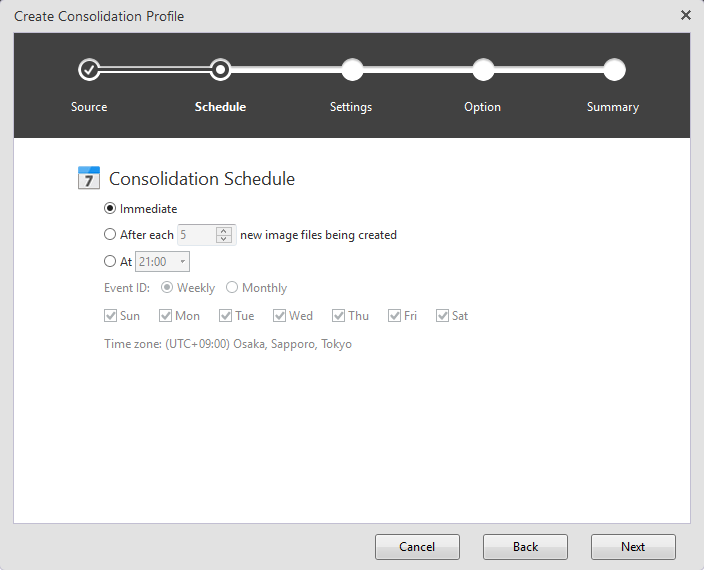
-
Immediate
The task is immediately executed upon creation of a new image. -
After each xx new image files being created The task is executed when xx number of image files are created.
-
At xx:xx
The created task is weekly / monthly executed at the specified time.
Settings
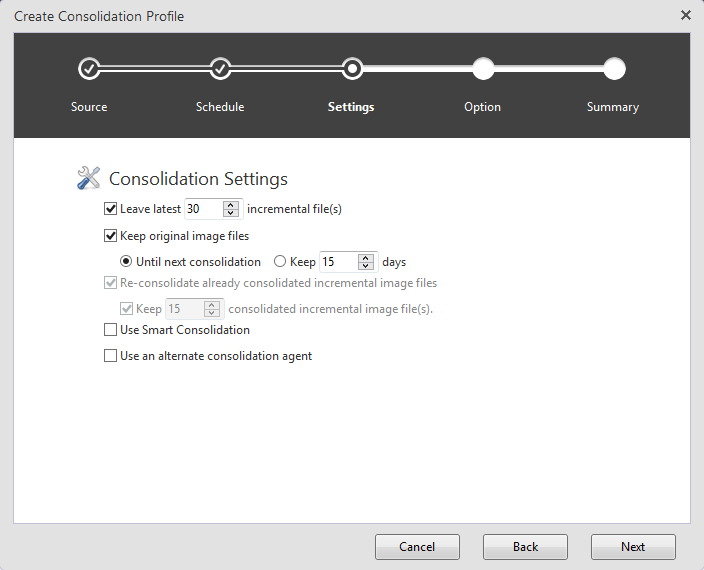
-
Leave latest xx incremental file(s)
Specify a number of incremental files to retain after consolidation. The Consolidation task is executed only when the specified number or more of incremental images remain in the latest image set. -
Keep original image files
Select this option to retain the original image files. Also select [Until next consolidation] or [Keep xx days] option. When Consolidation task is executed, a folder “Consolidate_original” is created in the image folder to save the original files. -
Re-consolidate already consolidated incremental image files Select this option to include previously consolidated image files in the consolidation source files for the next scheduled consolidation task. When enabled, the specified number of consolidated incremental image files may be retained.
This option is disabled if configuring for an [Immediate] schedule type.
-
Use Smart Consolidation
Select this option to reduce storage demands by removing deleted file data blocks during consolidation. -
Use an alternate consolidation agent Select this option enabling the use of the alternate consolidation agent (ImageCenter) for consolidation of images in this image set.
Option
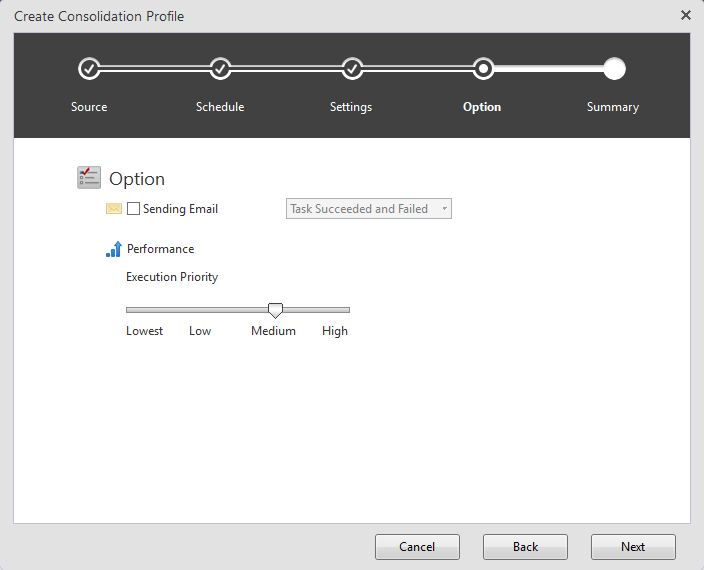
-
Sending Email
Enable this option to send an email notification of a task completed with a specified status. -
Performance
Set the Consolidation task execution priority.
Summary
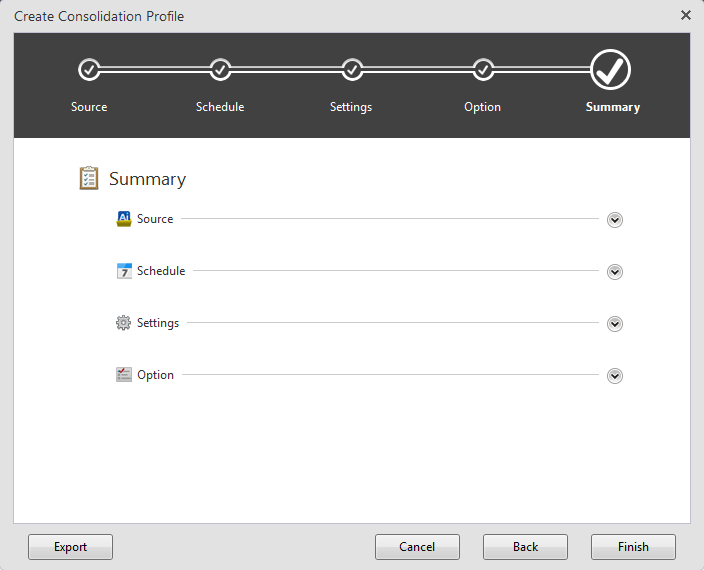
Click [Finish] to complete and save the Consolidation task configuration.
Click [Export] to export and save the template (*.consolidation) of Consolidation task configuration.
Create BootCheck
Running BootCheck task requires a hypervisor (Hyper-V) configured on local or remote host.
When using Hyper-V configured on remote host, BootCheck task using a backup image of the remote host fails.
Running BootCheck task requires 2GB of memory space on hypervisor. If only insufficient memory space is available, the BootCheck task will be in wait state.
BootCheck supports Windows Desktop OS only when using Hyper-V configured on local host. BootCheck does not support Windows Desktop OS when using Hyper-V configured on remote host.
Source
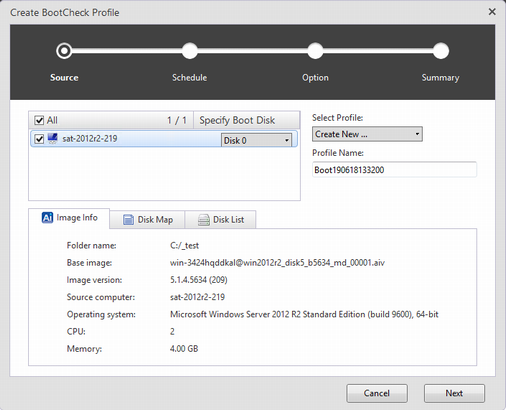
Multiple check boxes can be checked in the machine list. A single task may be created for multiple machines. Select a disk in [Specify Boot Disk] to run BootCheck from the disks included in the machine information.
Select [Create New] in [Select Profile] and specify the profile name.
When importing an exported profile, select [Create from a template…].
The following are the status of the image file.
-
Managed
Image file which you configured a task setting. -
Unmanaged
Image file which neither you nor any other user configured a task setting. -
External
Image file which a user other than you configured a task setting. -
Managed + External
Image file which you or any other user configured a task setting.
Schedule
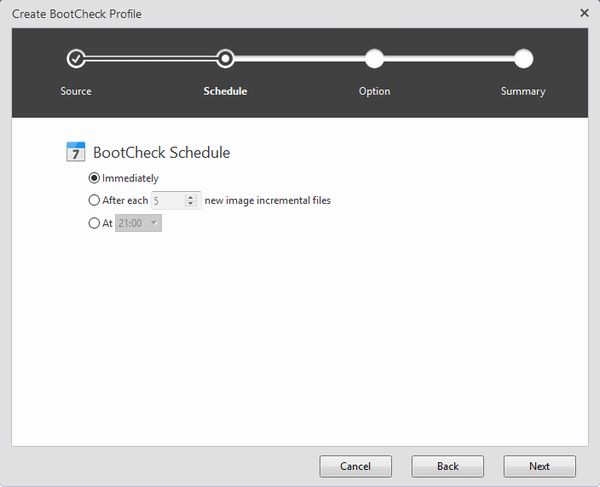
-
Immediate
The task is immediately executed, upon creation of a new image. -
After each xx new image files being created
The task is executed when xx number of image files are created. -
At xx:xx
The created task is daily executed at the specified time.
Option
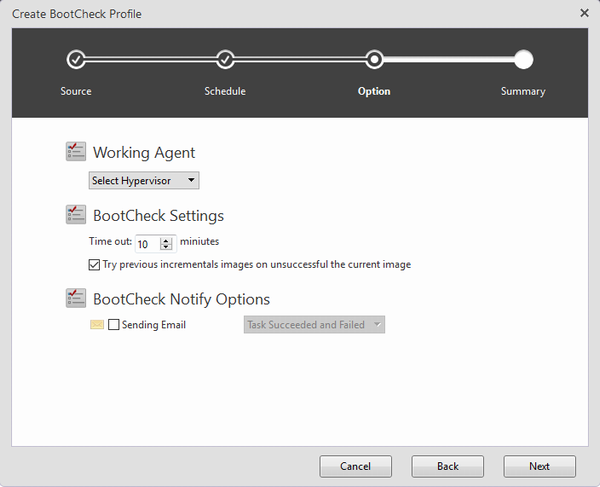
-
Working Agent
Please select a hypervisor to use for running BootCheck. -
Time-out xx minutes
Specify the time-out period to wait until BootCheck task completes. If the BootCheck task does not complete within the specified time-out period, the task fails. -
Try previous incremental images on unsuccessful the current image
In the event that the latest image does not boot up, run BootCheck task for the previously created image. If this option is not enabled, BootCheck task is executed for the latest image only. -
Sending Email Enable this option to send an email notification of a completed task with a specified status.
Summary
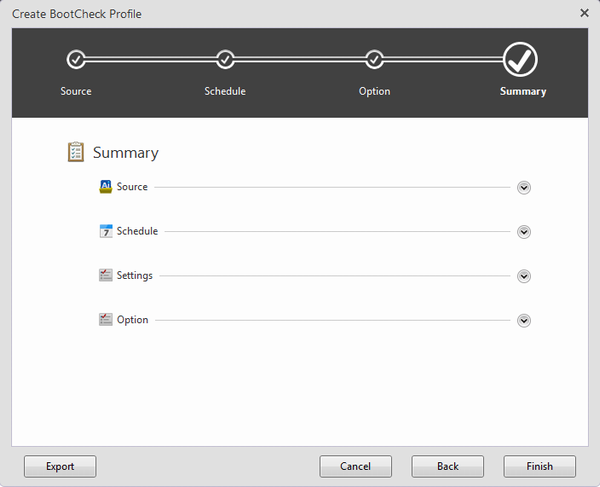
Click [Finish] to complete and save the BootCheck task configuration.
Click [Export] to export and save the template (*.bootcheck) of BootCheck task configuration.